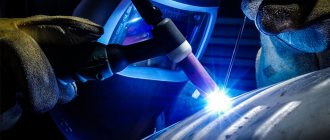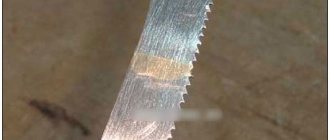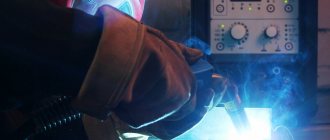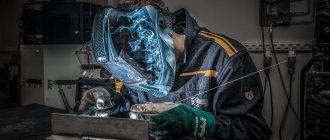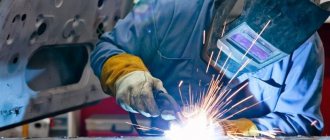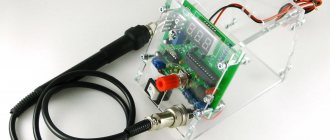Argon welding is an indispensable method with which you can create permanent joints of products made of non-ferrous metals, titanium, stainless steel and other alloys. In addition, this type of welding is characterized by good seam quality and high productivity. The universal capabilities of argon welding also attract home craftsmen. But this equipment is expensive and is practically not purchased for home use. Therefore, more and more craftsmen are starting to think about making an argon welding unit with their own hands.
Welding ferrous metal with argon: technologies, electrodes and features
Argon welding of ferrous metal falls into the category of a relatively low level of complexity of work. This process is characterized by the presence of quality welding activities.
In most cases, argon welding of iron is used to resolve complex situations when work is carried out using metal elements that are difficult to weld, for which there is a high risk of defects and defects.
Ferrous metal is characterized by a high level of welding in the presence of various types of conditions with a positive result.
In order to weld ferrous metal, a special element is used in the form of filler wire without a protective coating. In order to create a protective environment in the area of the weld pool from the action of external factors such as dirt, debris, and the supply of oxygen from the atmosphere, argon is used.
The essence of the ferrous metal welding process
A fundamental nuance that can create discomfort during welding work is the presence of boiling in the area of the weld pool. This process occurs as a result of insufficient heating of the metal being processed. In order to level out the likelihood of such a development of events, it is recommended to make the correct choice of filler material with the simultaneous use of flux, which contributes to the necessary heating of the workpiece.
During the welding of iron with the special thinness of the metal being processed, due to the presence of the argon component, accelerated welding work is achieved due to the absence of the likelihood of burning through the part used. As a result, a welding joint of improved quality is formed, which affects the strength and durability of the product.
Advantages of the welding process
In the course of welding work, it is considered possible to highlight specific positive aspects, among which there are such points as:
- ease of implementation of the process of welding metal of increased thinness;
- reducing the likelihood of defects and defects in the workpiece;
- the possibility of using welding seams of this nature everywhere in numerous areas;
- relative ease of implementing the welding process in practice;
- eliminating the possibility of failure at the moment of arc ignition;
- creation of continuous welding seams by using wire of the required length;
- the possibility of heating the metal being processed using burner gas;
- minimal need for preparatory work in relation to the metal being welded.
Disadvantages of the Welding Process
As with any process and activity, welding iron with argon has inherent disadvantages. Some of these uncomfortable aspects include:
- the presence of an increased cost of the process compared to other types of welding work;
- high probability of transition of the category of work performed to the group of risky activities due to the presence and direct use of the gas component;
- the presence of boiling situations in the area of the weld pool, which is accompanied by the phenomenon of splashing of the metal component in different directions from the place of welding work, which results in a connection of poor quality with the immediate formation of life-threatening conditions;
- insufficient representation and availability of certain devices necessary for organizing the welding process.
Welding tool
The degree of quality obtained as a result of welding work significantly depends on the materials used, as well as the tool that will directly carry out the process. In order to find the answer to the question of how to qualitatively weld iron, it is important to understand the importance of studying the technology of work, but also the dependence of the welding result on the composition of the metal involved in the welding process.
https://www.youtube.com/watch?v=efldsGcHNxg
At times it is quite difficult to determine the exact structure of the material being welded, as a result of which it is considered acceptable to use common brands of constituent elements of the welding process.
It should be remembered that the basis for the success of the work depends on how the specialist will weld the iron with a welding machine, taking into account compliance with the set modes, which will take into account the thickness of the material used.
Technological aspect of the welding process
Before welding thin iron with an electrode, it is important to carry out preparatory work, namely, clean the future connecting point. It is assumed that the oil film will be removed using a solvent or other chemical substance. Then you should place the flux on the surface of the metal being processed and set the necessary parameters.
During welding work, safety rules must be observed. At the end of the process, it is recommended to evaluate the quality of the welding performed.
Interesting video
Source: https://osvarka.com/svarka-metallov/svarka-cernogo-metalla-argonom
Algorithm for assembling a welding machine
Assembling equipment for argon welding from an inverter is quite simple.
- Connect the protective unit with the oscillator to the inverter according to the diagram above.
- The ground cable must be connected to the oscillator terminal with the “+” sign. The cable that goes to the burner is connected to the terminal with the “-” sign. For aluminum welding, the cables are connected in reverse.
- Connect the burner to the sleeve with the cable and gas hose.
- Screw the reducer to the argon cylinder.
- The gas hose must be connected to a reducer mounted on an argon cylinder.
- Connect the inverter to a 220 V network, and the oscillator to a 6 V power supply.
After this, the DIY TIG welding machine will be ready for use. But first it must be configured correctly.
Welding stainless steel and ferrous metal
There are never any questions when welding metals of identical composition is performed. Problems arise when two different workpieces are welded. And, most likely, not problems, but difficulties related to the correct selection of welding technologies and modes, as well as consumables.
For example, welding stainless steel and ferrous metal. It seems like two steels, but with different technical properties. Therefore, to weld these two alloys correctly means to accurately select the parameters of the welding process.
After all, the welded seam will hold both workpieces firmly only if it consists of the same metal as the parts being welded.
With black metal everything is more or less clear. This is the most common material that can be easily welded with any type of welding. With stainless steel everything is much more complicated.
Features of stainless steel welding
There are four technical characteristics of stainless steel that make its welding special.
- Low thermal conductivity of metal. If we compare this indicator with black steel, then it is two times lower for stainless steel. This suggests that in the process of heating the metal, it does not remove thermal energy, but accumulates it. And this is fraught with an increase in temperature in a certain area, which during welding will certainly lead to burn-throughs. This problem can be solved simply - you need to reduce the current by 20-30%.
- The linear expansion of stainless steel is higher than that of ferrous metal. Why is this value so important? The thing is that after a large expansion, when heated, the reverse process will occur - shrinkage by the same amount as the expansion. That is, two workpieces can break the welding seam, or a large number of cracks will appear in it. The way out is a large gap between the parts being welded.
- Electrical resistance. This indicator for stainless steel is also high. It affects the electrode, or rather its overheating during the welding process of stainless steel and steel. Therefore, it is necessary to reduce the length of the consumable to a limit of 35 cm, no more.
- Stainless steel changes its properties when exposed to high temperatures. That is, it turns from stainless steel into ordinary steel. Therefore, it is very important not to overheat it. At +500C, a carbide compound is formed on the metal grains, which reduces the anti-corrosion properties of stainless steel. Essentially, corrosion begins to occur at the intercrystalline bonds. This problem is solved in different ways, for example, the parts being welded are cooled with water.
Is it possible and how to weld stainless steel with ferrous metal? A question that requires a special approach. The main thing is to choose the right welding technology. To do this, you can use:
- Manual arc welding with a consumable electrode.
- Non-consumable tungsten electrode in a protective gas environment with or without an additive.
Elements for assembling a homemade apparatus
To assemble equipment for argon welding, you will need the following items:
- DC or inverter type welding machine;
- oscillator;
- inverter protection unit;
- burner;
- argon cylinder;
- gas reducer;
- gas hose;
- welding cables.
Current source
As a current source for TIG welding, you can take a regular welding transformer and adapt a diode bridge at its output to rectify the current. You can also use a welding straightener. But for both types of devices, you will also need to add an oscillator, which will facilitate contactless ignition of the arc.
On the Internet you can read that the easiest way to do argon welding is from an inverter. But there are several nuances here. There are inverters that already have built-in TIG welding capabilities. In this case, it is enough to connect a hose with a torch for argon welding to the device, connect the hose to an argon cylinder, and the unit is ready for work. But first you need to switch it to TIG mode and set the required current.
It should be noted that such inverters already have a built-in oscillator and the necessary protection.
Inverters without a built-in TIG welding function cannot be used for this purpose. Even if you connect an external oscillator to it, the inverter will simply burn out. To prevent this from happening, you will need a small modification of the inverter, which consists of adding a protection unit to its circuit. This block can be assembled together with the oscillator on one board and placed in a separate case. You will get a small attachment for the inverter.
Oscillator and protection unit
As mentioned above, a welding inverter will require a special attachment for TIG welding. You can assemble it with your own hands according to the diagram provided below.
This circuit includes a protection block (located on the left) and an oscillator. The latter can be purchased in China or assembled yourself. You can find out how the above circuit is assembled by watching this video.
Burner
For argon welding, a special torch is used, consisting of a ceramic nozzle and a tungsten electrode holder.
Also on the burner there is a start button and a gas supply valve. The burner can be assembled from components, which are sufficient on Chinese websites, or you can buy a ready-made (assembled) one there.
Argon cylinder
For safety reasons, it is customary to paint all gas cylinders in different colors and put inscriptions on them in different colors. Below is a picture that shows all types of gas cylinders with markings and colors corresponding to their contents.
As can be seen from the figure, black (with a white stripe) or gray (with a green stripe and inscription) cylinders are used for argon. For TIG welding, purified argon is used. Therefore, you will need to purchase a gray cylinder with a green inscription “Pure Argon”.
Advice! For professional use, cylinders with a capacity of about 50 liters and a large weight are used. But for domestic use, a 10-liter cylinder will be sufficient, which can be moved independently.
Gearbox
Since the gas in the cylinder is under high pressure, a reducer is required to supply it to the burner. This device shows the pressure in the cylinder and allows you to adjust the gas flow rate through the hose leading to the burner.
The reducer must be selected strictly for a specific gas, that is, in this case, for argon. Usually the device has the same color as the gas cylinder.
Hose and welding cables
If you assemble a hose for argon welding yourself, it will turn out to be thick and difficult to bend, since you need to place an electric cable and a gas hose in it. In addition, you will need to separately purchase connectors for connecting to the torch and to the inverter (if you use an inverter with TIG welding capabilities). A ready-made sleeve for argon welding can be purchased in the same place as the torch.
TIG welding of ferrous metal
How is stainless steel welded with argon? The entire technology process will be covered in this publication!
Stainless steel belongs to high-alloy steels that are rust-resistant. According to the chemical composition, it is based on chromium and chromium-nickel, and according to the metal composition it is divided into dispersion-hardening, austenitic, martensitic, austenitic-ferritic and ferritic.
Any of the steels listed contains at least 12% chromium, which has a positive effect on strength and workability.
Due to its excellent properties, stainless steel is widely used in everyday life and industry. Therefore, having the skill of welding such metal, you will save yourself from many household troubles.
The material has a number of nuances that you should know:
- low thermal conductivity increases the risk of burning through thin metal (treated by reducing the current);
- large shrinkage causes the formation of cracks (the correct gap between the workpieces is necessary);
- loss of anti-corrosion properties at the welding site of stainless steel (rapid cooling required).
Equipment
To weld stainless steel, you need a power source with settings for: non-contact ignition and crater filling.
The filler rod must be of the same composition as the material being welded to provide the weld with strength and corrosion resistance. For example, the widely used stainless steel is 304, which means the wire should be Y308. More clearly in the table:
To reduce gas consumption and better protect the weld pool, use a gas lens with a mesh in the torch. Nozzles with different diameters are available for the lens. The larger the size, the better the protection.
For our purposes, No. 5 will do. This diameter allows you to get to hard-to-reach places.
Thanks to the gas lens, the electrode can be extended up to 10 mm.
Tungsten electrodes; when welding stainless steel with argon, you can use universal ones. The diameter depends on the thickness of the metal. For example, an electrode with a diameter of 1 mm (withstands current up to 50 A) is used for workpiece thicknesses of 0.7-1.6 mm.
For currents above 50 A, it is recommended to install electrodes from 1.6 mm.
Preparation of material
Just as you machine mild steel, stainless steel edges are cleaned and adjusted before welding. Clean the material with a steel brush until it shines and degrease it with any solvent.
Take into account the nuance - to shrink the seam, make the welding joint with a small gap.
Know that not everything shiny is stainless steel. You can check metal using a magnet:
- if there is no attraction, then we have stainless steel;
- if the material sticks to the magnet, then it is ordinary steel.
Thin metal connection
Welding thin stainless steel - nuances of technology. With this connection, it is recommended to place a copper plate under the workpieces.
Copper plate for comfortable connection of products
Which serves for:
- seam protection on the other side;
- heat removal;
- rigid fixation of flexible plates.
Correct device settings. Argon welding of stainless steel 1 mm thick is performed at 35-37 A mode and crater filling (DOWN SLOPE) for 3 seconds. Gas after welding (POST FLOW) can be set for 4 seconds - this is enough to cool the metal.
Setting up finished equipment
A homemade argon welding installation requires the following settings.
- Sharpen the tungsten electrode on a sharpener until it looks like a needle. This is done so that the arc is concentrated at the end of the needle and does not “walk” in different directions.
- Take a torch and install a tungsten electrode into it. The diameter of the electrode must correspond to the collet in which it is fixed.
- Open the valve on the burner and adjust the required argon flow rate using the reducer (a flow rate of 12-15 l/min will be sufficient), then close the valve on the burner again.
- Turn on the oscillator and bring the torch with the electrode to the metal to which the ground cable is connected.
- When you press the power button, an arc should appear between the metal and the electrode at a distance of about 0.5 mm.
- Turn on the gas supply and press the button again. In this case, the arc should be ignited at a distance of 10 mm or more.
After carrying out the simple settings described above, we can say that the device with the TIG function is completely ready for work.
How to weld ferrous metal with argon
Currently, one of the simplest, but at the same time high-quality and reliable connections is argon welding of ferrous metal. This type of welding work is very often used to create various seams in difficult-to-weld products, for example, for connecting parts made of steel.
Using argon-arc welding for iron or ferrous metal, which can be welded well under normal conditions, you can obtain a strong and reliable connection that will not undergo deformation. Welding ferrous metal requires regular wire of the required diameter without a protective coating.
How to weld ferrous metal and thin iron and what the features of the process are will be discussed in this article.
Features of argon welding
a difficulty that arises during the work process is the boiling of the weld pool. This happens because the metal is not heated enough. In order to avoid this negative phenomenon, you need to choose the right filler material, and also use flux, thanks to which the prepared part will melt better. By fulfilling all these requirements, you will greatly simplify your work and ultimately get a good seam.
On a note! The entire production process must be carried out in accordance with GOST 14771-76.
Advantages
If you weld ferrous metal workpieces using argon in accordance with all recommendations, the result will be the highest quality connection. Let's note the main advantages:
- The process is simple and short in time,
- the seams formed as a result of electrode welding can be suitable in almost every field,
- the arc ignites quickly and easily,
- due to the use of long wire, any seam can be performed continuously,
- The metal products themselves can be heated with burner gas.
Disadvantages
Despite the large number of advantages, there are also a number of disadvantages:
- tig welding is a fairly expensive process; when compared with conventional arc welding, the cost of the former will be 10 times more,
- since gas is used, the work is unsafe,
- there is a risk that the weld pool may boil and, as a result, the metal will splash in different directions, which can result in contact with unprotected areas of the body and the quality of the connection will be significantly worse,
- It may be difficult to find some of the materials needed for this type of welding.
However, all the disadvantages described will be insignificant compared to the quality of the connection you can end up with. In addition, if you approach the process responsibly, then such shortcomings can be completely avoided.
Tool selection criteria
In many ways, the successful execution of a seam depends on the correctly selected tool and materials that you will use. The filler material should be as suitable as possible for the metal product being welded. Therefore, it is very important to know all the components of the metal. However, this is not always possible to achieve; therefore, the main guideline is the popular brands of wire that are most often used. Most professionals recommend using Sv-08G2S.
When choosing wire, pay attention to such a criterion as effervescence. Many users, not knowing how to weld ferrous metal, encounter this problem. To avoid this you need to look at the markings. If the KP value is indicated on the wire, this indicates that the metal is susceptible to boiling, so you should not buy such parts. Another important indicator is the diameter thickness of the filler material. You need to choose based on the thickness of the products being welded. Try to choose a material as similar to the density of the metal as possible.
Modes for welding ferrous sheet metal with argon
Even if you don’t have any experience, don’t worry, if you follow all the requirements you can get a good connection. In order for the final weld to be as strong and reliable as possible, it is necessary to correctly select the mode that will best suit the given thickness of the workpiece and other indicators.
Welding of ferrous metals
Product dimensions:
from 10 mm to 6 meters
Product thickness:
from 1 to 30 mm
black iron
How does it work
Welding is the creation of a permanent connection under the influence of high temperature. The materials being joined melt, and a weld pool is formed at the junction - the center of the weld.
There are several methods of welding ferrous metals: electric arc welding, gas welding, argon arc welding, also called argon welding.
Diametal specialists choose the optimal welding method, taking into account various parameters: thickness and composition of the metal, type of product, requirements for the weld.
Calculate the cost of welding ferrous metals in Diametal
To obtain a high-quality welded joint, the metal surface must be cleaned. See: metal cleaning.
Arc welding
The heat source that melts materials during electric arc welding is an electric arc, which is an electrical discharge between the part and the electrode.
Working principle of electric arc welding
In electric arc welding, a low voltage, high current power source is connected to the welding electrode and the workpiece being welded. When the electrode is brought to the part, a short circuit occurs. The part and surrounding gas heat up. Under the influence of temperature, the gas is ionized - divided into positively and negatively charged particles - ions.
Ionized gas, unlike non-ionized gas, conducts current, so when the electrode is withdrawn a short distance, 3–6 mm, an electric arc appears in the space between the electrode and the workpiece. It heats up to 6000 degrees and melts the material of the parts and the electrode, filling the space between the parts - the weld pool.
Thanks to the coating layer around the electrode, an environment is formed around the welding zone that prevents air from entering. It stabilizes the arc pressure and forms a protective film on the surface of the seam.
Arc welding. Advantages and disadvantages
- — Internal thermal stresses. Due to strong heating, the structure of the metal changes.
- - Wide seam. Due to the oscillatory movements, the seam extends onto the materials being welded.
- + Welding of parts of any thickness.
- + High speed.
- + Safer than gas welding.
Argon arc welding (argon welding)
When electric arc welding of alloy steels, air enters the weld pool. The oxygen contained in it oxidizes the seam. The seam turns out to be fragile, some materials are burned through.
To protect metals from oxidation, a protective medium is used - neutral argon gas. Argon is ⅓ denser than air, so it does not allow air into the arc combustion area. This welding is called argon arc welding or argon welding.
Working principle of argon arc welding
Identical to electric arc welding. The difference is that argon is supplied 20–30 seconds before the arc ignites. The gas supply stops 5–10 seconds after completion of work. The temperature of argon arc welding is lower than electric arc welding - up to 2000 degrees.
Two types of argon-arc welding are used:
- TIG - argon arc welding with non-consumable tungsten electrodes
- MIG/MAG - argon-arc welding with electrode wire.
Argon-arc welding. Advantages and disadvantages
- — Slower than electric arc welding.
- — Difficult to apply outdoors.
- + The wind blows away the argon.
- + Neat seam.
- + No oscillatory movements of the electrode are used.
- + No overheating. Heating of the metal is uniform.
- + Work with non-ferrous and thin metals.
Gas welding
Metal melting during gas welding occurs from the combustion of a mixture of oxygen and acetylene. Propane or methane is less commonly used.
Working principle of gas welding
The gas mixture is ignited and directed to the materials being welded. Filler wire is used to fill the weld pool. Usually its material coincides with the material of the parts being welded.
When gas welding, special pastes or powders are used - fluxes. They form slags on the surface of the liquid metal, protecting the seam from oxidation. The combustion temperature of the gas welding flame is 3200 degrees.
Gas welding. Advantages and disadvantages
- — Low speed gas welding of thick parts. The entire thickness needs to be heated.
- — Possible deformation of the structure.
- — Explosion and fire hazard.
- + Cooks cast iron.
- + It is easier to weld thin-walled metal.
- + Easy temperature adjustment by changing the flame angle.
Welding ferrous metals in Diametal in 5 stages
- Coordination. Selecting the optimal type of welding. If there is no drawing, we will make it ourselves according to your sketch.
- Prepayment. Required to get started.
- Welding. 500–1000 parts from 2 working days, 1000–5000 parts from 5 working days.
- Quality control. We check compliance with the dimensions of the drawing and the quality of welded joints.
- Payment and delivery. With our own vehicles in St. Petersburg and the Leningrad region.
Types
Tungsten electrodes are divided into three types: 1. For alternating current. Used to work with magnesium, aluminum, their varieties and alloys, if it is necessary to protect the bath from dirt. 2. For direct current. Yttrium or thorium is introduced into these welding rods. The last element is radioactive. It is not recommended to get carried away with working in enclosed spaces. Used for welding copper, titanium, nickel, tantalum, bronze, austenitic steels (stainless steel), carbon alloys. 3. Universal electrodes. They perform remarkably well in both alternating and direct current. The use of “station wagons” is common in pipeline work. They connect thin sheet metal well and discreetly.
